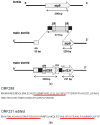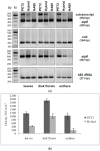Recombination Events Involving the atp9 Gene Are Associated with Male Sterility of CMS PET2 in Sunflower
- PMID: 29534485
- PMCID: PMC5877667
- DOI: 10.3390/ijms19030806
Recombination Events Involving the atp9 Gene Are Associated with Male Sterility of CMS PET2 in Sunflower
Abstract
Cytoplasmic male sterility (CMS) systems represent ideal mutants to study the role of mitochondria in pollen development. In sunflower, CMS PET2 also has the potential to become an alternative CMS source for commercial sunflower hybrid breeding. CMS PET2 originates from an interspecific cross of H. petiolaris and H. annuus as CMS PET1, but results in a different CMS mechanism. Southern analyses revealed differences for atp6, atp9 and cob between CMS PET2, CMS PET1 and the male-fertile line HA89. A second identical copy of atp6 was present on an additional CMS PET2-specific fragment. In addition, the atp9 gene was duplicated. However, this duplication was followed by an insertion of 271 bp of unknown origin in the 5' coding region of the atp9 gene in CMS PET2, which led to the creation of two unique open reading frames orf288 and orf231. The first 53 bp of orf288 are identical to the 5' end of atp9. Orf231 consists apart from the first 3 bp, being part of the 271-bp-insertion, of the last 228 bp of atp9. These CMS PET2-specific orfs are co-transcribed. All 11 editing sites of the atp9 gene present in orf231 are fully edited. The anther-specific reduction of the co-transcript in fertility-restored hybrids supports the involvement in male-sterility based on CMS PET2.
Keywords: CMS PET1; CMS PET2; Helianthus annuus; RNA-editing; atp9; cytoplasmic male sterility; plant mitochondria; recombination; respiration.
Conflict of interest statement
The authors declare no conflict of interest.
Figures









Similar articles
-
Characterization of the mitochondrial genome of the MAX1 type of cytoplasmic male-sterile sunflower.BMC Plant Biol. 2019 Feb 15;19(Suppl 1):51. doi: 10.1186/s12870-019-1637-x. BMC Plant Biol. 2019. PMID: 30813888 Free PMC article.
-
Mapping of the New Fertility Restorer Gene Rf-PET2 Close to Rf1 on Linkage Group 13 in Sunflower (Helianthus annuus L.).Genes (Basel). 2020 Mar 1;11(3):269. doi: 10.3390/genes11030269. Genes (Basel). 2020. PMID: 32121545 Free PMC article.
-
Mitochondrial genomes organization in alloplasmic lines of sunflower (Helianthus annuus L.) with various types of cytoplasmic male sterility.PeerJ. 2018 Jul 23;6:e5266. doi: 10.7717/peerj.5266. eCollection 2018. PeerJ. 2018. PMID: 30057860 Free PMC article.
-
Past and future of cytoplasmic male sterility and heterosis breeding in crop plants.Plant Cell Rep. 2025 Jan 22;44(2):33. doi: 10.1007/s00299-024-03414-5. Plant Cell Rep. 2025. PMID: 39841239 Review.
-
Non-coding RNAs and plant male sterility: current knowledge and future prospects.Plant Cell Rep. 2018 Feb;37(2):177-191. doi: 10.1007/s00299-018-2248-y. Epub 2018 Jan 13. Plant Cell Rep. 2018. PMID: 29332167 Review.
Cited by
-
A Systematic Review and Developmental Perspective on Origin of CMS Genes in Crops.Int J Mol Sci. 2024 Jul 31;25(15):8372. doi: 10.3390/ijms25158372. Int J Mol Sci. 2024. PMID: 39125940 Free PMC article.
-
Assembly and comparative analysis of the complete mitochondrial genome of Isopyrum anemonoides (Ranunculaceae).PLoS One. 2023 Oct 5;18(10):e0286628. doi: 10.1371/journal.pone.0286628. eCollection 2023. PLoS One. 2023. PMID: 37796878 Free PMC article.
-
Characterization of the mitochondrial genome of the MAX1 type of cytoplasmic male-sterile sunflower.BMC Plant Biol. 2019 Feb 15;19(Suppl 1):51. doi: 10.1186/s12870-019-1637-x. BMC Plant Biol. 2019. PMID: 30813888 Free PMC article.
-
Deciphering the mitochondrial genome of Hemerocallis citrina (Asphodelaceae) using a combined assembly and comparative genomic strategy.Front Plant Sci. 2022 Nov 18;13:1051221. doi: 10.3389/fpls.2022.1051221. eCollection 2022. Front Plant Sci. 2022. PMID: 36466251 Free PMC article.
-
Development and Validation of Markers for the Fertility Restorer Gene Rf1 in Sunflower.Int J Mol Sci. 2019 Mar 13;20(6):1260. doi: 10.3390/ijms20061260. Int J Mol Sci. 2019. PMID: 30871146 Free PMC article.
References
-
- Kaul M.L.H. Male Sterility in Higher Plants. Monographs in Theoretical and Applied Genetics. Springer; Berlin/Heidelberg, Germany: New York, NY, USA: 1988.
-
- Laser K.D., Lersten N.R. Anatomy and cytology of microsporogenesis in cytoplasmic male sterile angiosperms. Bot. Rev. 1972;33:337–346. doi: 10.1007/BF02860010. - DOI
MeSH terms
Substances
LinkOut - more resources
Full Text Sources
Other Literature Sources

